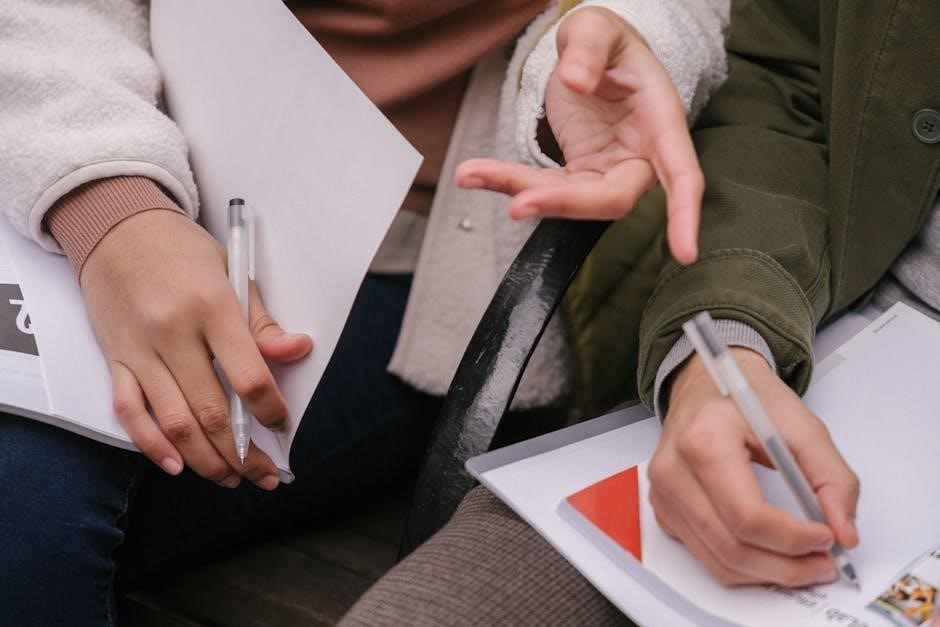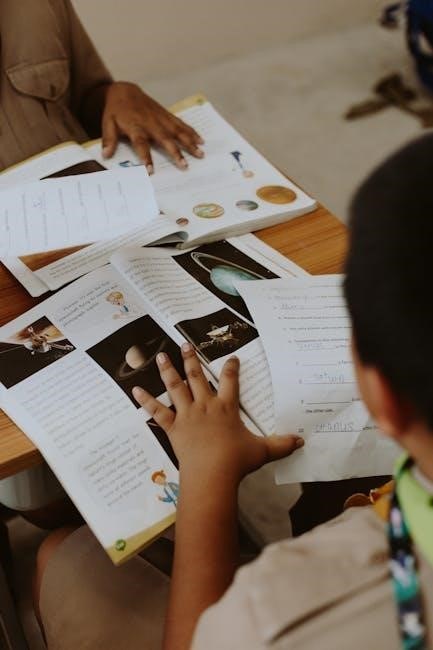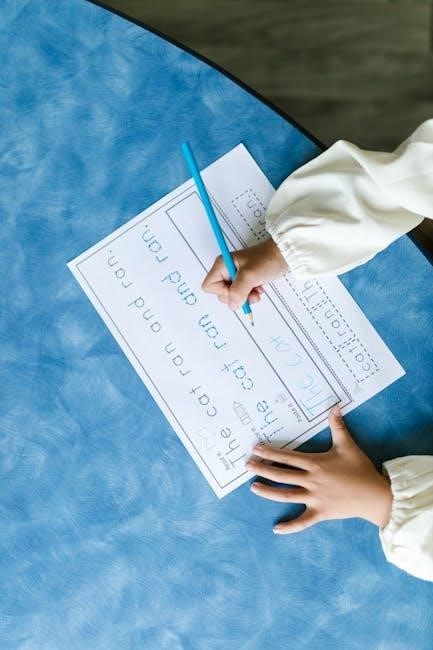Mastering the skill of adding and subtracting fractions with unlike denominators is essential for students to build a strong foundation in mathematics․ This topic focuses on finding common denominators, converting fractions, and simplifying results․ Worksheets and activities provide hands-on practice, making learning engaging and effective for all skill levels․
1․1․ Understanding the Basics of Fractions

Fractions represent parts of a whole or parts of a group․ A fraction consists of a numerator (top number) and a denominator (bottom number), which indicates the total number of equal parts․ For example, in 1/2, the numerator is 1, and the denominator is 2․ Fractions can be proper (numerator < denominator), improper (numerator ≥ denominator), or mixed numbers (a combination of a whole number and a fraction)․ Understanding fractions is essential for operations like addition and subtraction, especially when dealing with unlike denominators․
1․2․ What Are Unlike Denominators?
Unlike denominators refer to fractions that have different bottom numbers, or denominators, which represent the total number of equal parts․ For example, 1/2 and 1/3 have unlike denominators because their denominators (2 and 3) are not the same․ This makes it challenging to compare or perform arithmetic operations directly․ Unlike denominators require finding a common denominator to align the fractions for easy addition or subtraction․ This concept is crucial in real-world scenarios, such as cooking or construction, where precise measurements are essential․

1․3․ Why Adding and Subtracting Fractions with Unlike Denominators is Important
Mastering the ability to add and subtract fractions with unlike denominators is essential for building a strong foundation in mathematics․ This skill is widely applicable in real-world scenarios, such as cooking, where adjusting recipes requires precise measurements․ It also plays a critical role in fields like construction, engineering, and finance, where accurate calculations are necessary․ Understanding this concept enhances problem-solving abilities and prepares students for more complex mathematical operations in algebra and higher-level subjects․ Regular practice ensures proficiency and confidence in handling fraction-related tasks․

The Process of Adding and Subtracting Fractions with Unlike Denominators
This process involves finding a common denominator, converting fractions, and performing arithmetic operations․ It ensures accurate results in various mathematical and real-world applications․
2․1․ Finding the Least Common Denominator (LCD)
The least common denominator (LCD) is the smallest number that both denominators can divide into evenly․ To find the LCD, list the multiples of each denominator until a common multiple is found․ Alternatively, use prime factorization to identify the highest powers of all prime numbers involved and multiply them together․ This method ensures the LCD is the smallest possible, making calculations more manageable․ Accurately finding the LCD is essential for correctly adding and subtracting fractions with unlike denominators․ This step is crucial because it allows the fractions to be converted to equivalent fractions with the same denominator, facilitating accurate addition or subtraction․
2․2․ Converting Fractions to Have the Same Denominator
Once the LCD is identified, each fraction is converted to an equivalent fraction with the LCD as the denominator․ This is done by multiplying both the numerator and the denominator of each fraction by the same number․ For example, to convert 1/2 and 1/3 to fractions with a common denominator of 6, multiply 1/2 by 3/3 and 1/3 by 2/2, resulting in 3/6 and 2/6․ This step ensures the fractions can be easily added or subtracted by aligning their denominators, maintaining the value of each fraction during the process․
2․3․ Performing the Addition or Subtraction
After converting fractions to have the same denominator, add or subtract the numerators while keeping the denominator the same․ For example, to add 3/6 and 2/6, simply add the numerators: 3 + 2 = 5, resulting in 5/6․ Similarly, subtracting numerators works the same way, such as 5/6 ⏤ 2/6 = 3/6․ Ensure the denominator remains unchanged throughout the operation․ This step is straightforward once the fractions are aligned with the same denominator, making the calculation efficient and accurate․
2․4․ Simplifying the Result

After performing the addition or subtraction, simplify the resulting fraction if possible․ To do this, identify the greatest common divisor (GCD) of the numerator and denominator․ Divide both by the GCD to reduce the fraction to its simplest form․ For example, if the result is 4/8, divide both by 4 to get 1/2․ Always ensure the fraction is in its lowest terms by checking for common factors․ Proper simplification is essential for clear and accurate results;

Step-by-Step Guide to Solving Problems
Follow a systematic approach to solve problems involving fractions with unlike denominators․ 1․ Identify the denominators․ 2․ Calculate the LCD․ 3․ Adjust fractions․ 4․ Add or subtract numerators․ 5․ Reduce the result․ This method ensures accuracy and simplifies complex operations․
3․1․ Identifying the Denominators

Identifying the denominators is the first step in solving problems with unlike fractions․ The denominator is the number below the fraction bar, indicating the total number of equal parts․ For example, in the fraction 3/4, 4 is the denominator․ When working with multiple fractions, list all denominators to determine which ones are different․ This step is crucial because it guides the next process of finding a common denominator․ Always double-check to ensure accuracy, as misidentifying denominators can lead to incorrect solutions․
3․2․ Calculating the LCD
Calculating the Least Common Denominator (LCD) is essential for adding or subtracting fractions with unlike denominators․ The LCD is the smallest number that all denominators can divide into without a remainder․ To find it, list the multiples of each denominator and identify the smallest common multiple․ For example, for denominators 4 and 6, the multiples of 4 are 4, 8, 12, 16, and multiples of 6 are 6, 12, 18․ The LCD is 12․ This step ensures fractions can be converted to have the same denominator for easy calculation․
3․3․ Adjusting the Fractions
After finding the LCD, adjust each fraction to have this common denominator․ To do this, multiply both the numerator and the denominator of each fraction by the same number․ For example, if the LCD is 12 and a fraction has a denominator of 4, multiply the numerator and denominator by 3 to get 12․ This ensures all fractions have the same denominator, making addition or subtraction straightforward․ Always remember to keep the value of the fraction the same during this process․
3․4․ Adding or Subtracting the Numerators
Once the fractions have the same denominator, add or subtract the numerators while keeping the denominator the same․ For example, if you have 3/8 and 5/8, add the numerators: 3 + 5 = 8, resulting in 8/8․ If subtracting, such as 7/10 ― 3/10, subtract the numerators: 7 ― 3 = 4, resulting in 4/10․ Always ensure the denominator remains unchanged during this step․ Simplify the fraction if possible after performing the operation․
3․5․ Reducing the Fraction (if possible)
After adding or subtracting the numerators, check if the resulting fraction can be simplified․ To reduce a fraction, find the greatest common divisor (GCD) of the numerator and the denominator․ Divide both by the GCD․ For example, if the result is 8/8, divide both by 8 to get 1․ If the result is 4/10, divide both by 2 to get 2/5․ If the fraction cannot be simplified further, like 3/7, it remains as is․ Always ensure the fraction is in its simplest form before finalizing your answer․

Worksheet Activities for Practice
Engage with various worksheet activities to enhance your skills in adding and subtracting fractions with unlike denominators․ Practice with grade-specific problems, mixed operations, and real-world applications to build confidence and mastery;

4․1․ Printable Worksheets for Different Grade Levels
Access a variety of printable worksheets tailored to different grade levels, ensuring appropriate difficulty for each student․ These worksheets focus on adding and subtracting fractions with unlike denominators, offering clear instructions and ample practice problems․ They are ideal for classroom use, homework, or independent study․ Many include answer keys for easy grading and self-checking․ Choose from basic exercises for younger learners to more complex problems for advanced students, all designed to reinforce understanding and mastery of fraction operations․
4․2․ Mixed Problems (Addition and Subtraction Combined)
Mixed problem worksheets combine addition and subtraction of fractions with unlike denominators, testing students’ ability to apply their understanding in varied scenarios․ These exercises mimic real-world situations where both operations are often required․ They help students develop problem-solving skills by identifying whether to add or subtract based on the context․ Mixed problems also challenge students to carefully manage multiple steps, ensuring they find the LCD, adjust fractions, and simplify correctly․ Educators can use these to assess comprehensive mastery of fraction operations․
4․3․ Word Problems Involving Fractions
Word problems involving fractions provide real-world context for adding and subtracting fractions with unlike denominators․ These problems often simulate scenarios like cooking, shopping, or crafting, where fractions are naturally used․ Students learn to interpret and translate words into mathematical operations, enhancing their critical thinking and problem-solving skills․ Worksheets include a variety of word-based challenges, such as mixing ingredients or calculating costs, ensuring practical application of fraction operations․ This helps bridge abstract concepts with tangible, everyday situations, fostering deeper understanding and mastery․
4․4․ No-Prep and Digital Versions
No-prep and digital versions of worksheets offer convenience and flexibility for teachers and students․ These resources require minimal setup, saving time and effort․ Digital versions are accessible on devices, making them ideal for remote learning or interactive lessons․ They often include features like auto-grading and interactive exercises, enhancing engagement․ Printable no-prep options reduce paper waste and are easily distributed․ These formats cater to modern teaching needs, providing efficient and adaptable tools for practicing fraction operations in a variety of settings․ They support differentiated instruction and student accessibility seamlessly․

Teaching Tips and Strategies
Effective strategies include breaking problems into steps, using visual models, and incorporating real-world examples․ Technology tools and collaborative learning also enhance understanding and engagement․
- Use manipulatives for hands-on practice․
- Incorporate games to make learning fun․
- Provide step-by-step guidance for complex problems․
These approaches help students grasp fraction concepts confidently and efficiently, fostering a strong foundation for future math skills․ Regular practice and feedback are essential for mastery․ Encourage critical thinking and problem-solving through diverse activities․ Make learning interactive and relatable to ensure long-term retention and understanding․ Always simplify complex concepts for clarity and accessibility․ Offer individualized support to address unique learning needs and pace․ Celebrate progress to build confidence and motivation․ Utilize formative assessments to track growth and adjust instruction accordingly․ Foster a growth mindset to embrace challenges and view mistakes as learning opportunities․ Create a supportive environment where questions and discussions are encouraged․ Integrate cross-curricular connections to highlight the relevance of fractions in real life․ Stay flexible and adapt strategies to meet the evolving needs of your students․ Leverage technology for personalized learning experiences and interactive exercises․ Provide clear explanations and demonstrations to ensure comprehension․ Encourage peer teaching to reinforce learning and promote collaboration․ Use formative assessments to identify areas needing review․ Offer choices in activities to cater to different learning preferences․ Incorporate movement and hands-on activities to keep students engaged․ Use storytelling and scenarios to make abstract concepts concrete․ Celebrate small victories to maintain motivation and morale․ Foster a sense of accomplishment with achievable goals and recognition․ Stay organized with structured lesson plans and materials․ Continuously seek professional development to enhance teaching methods․ Build strong relationships with students to create a positive learning atmosphere․ Be patient and persistent in guiding students toward mastery․ Adapt teaching methods to align with curriculum standards and objectives․ Use data to inform instruction and make targeted interventions․ Encourage self-reflection and metacognition to deepen understanding․ Provide opportunities for creative expression and application of fraction skills․ Stay updated with educational research and best practices․ Collaborate with colleagues to share resources and strategies․ Advocate for student well-being to support academic success․ Embrace diversity and inclusivity in teaching approaches․ Use humor and positivity to create an enjoyable learning environment․ Be approachable and available for individual support․ Encourage parental involvement to extend learning beyond the classroom․ Use a variety of assessment methods to measure progress․ Provide constructive feedback that guides improvement․ Stay enthusiastic and passionate about teaching to inspire students․ Be flexible in responding to unexpected challenges and opportunities․ Use reflective practice to continuously improve teaching effectiveness․ Foster a love for learning that extends beyond the curriculum․ Stay committed to helping students achieve their full potential․ Regularly communicate with parents and guardians to ensure alignment․ Use a balanced approach that includes direct instruction and exploration․ Encourage active participation and ownership of learning․ Use a trauma-informed approach to create a safe space․ Stay culturally responsive to meet the needs of all students․ Use a strengths-based approach to build on student abilities․ Provide opportunities for leadership and responsibility․ Use restorative practices to build community and resolve conflicts․ Stay mindful of student well-being and mental health․ Use a growth mindset in your own professional development․ Be open to feedback and willing to adapt․ Stay organized and manage time effectively to meet deadlines․ Use a variety of teaching tools and resources to enhance lessons․ Incorporate music and art to make learning multisensory․ Use a project-based approach to integrate multiple skills․ Provide opportunities for reflection and self-assessment․ Stay positive and solution-focused when addressing challenges․ Be proactive in anticipating and addressing student needs․ Use a differentiated approach to meet diverse learning styles․ Stay tech-savvy to integrate digital tools effectively․ Provide scaffolding to support students at all levels․ Use a balanced literacy approach to develop math literacy․ Incorporate movement breaks to maintain focus and energy․ Use a tiered approach to differentiate instruction․ Provide choices to empower students and increase motivation․ Use a flipped classroom model to extend learning․ Stay current with educational trends and innovations․ Be visible and approachable to students and parents․ Use a variety of grouping strategies to promote collaboration․ Provide opportunities for student voice and choice․ Use a mindfulness approach to reduce stress and improve focus․ Stay committed to ongoing professional growth and development․ Be passionate about making a positive impact on students’ lives․ Use a holistic approach to address the whole child․ Stay dedicated to fostering a love for mathematics․ Use a variety of formative assessments to monitor progress․ Provide timely and specific feedback to guide learning․ Stay positive and encouraging to build student confidence․ Use a variety of summative assessments to evaluate mastery․ Provide opportunities for reteaching and reassessment․ Stay flexible in response to student needs and feedback․ Use a data-driven approach to inform instruction․ Be proactive in addressing learning gaps․ Use a collaborative approach to work with other educators․ Stay organized with clear lesson plans and materials․ Provide opportunities for student-led discussions and presentations․ Use a variety of technology tools to enhance engagement․ Stay committed to continuous improvement in teaching practices․ Be approachable and willing to listen to student concerns․ Use a variety of strategies to support English learners․ Stay culturally aware and sensitive to student backgrounds․ Use a variety of accommodations to support special needs․ Provide opportunities for extension and enrichment․ Stay positive and resilient in the face of challenges․ Use a variety of strategies to manage classroom behavior․ Be proactive in creating a positive classroom culture․ Use a restorative approach to build relationships and resolve conflicts․ Stay committed to social-emotional learning․ Use a variety of strategies to promote student engagement․ Provide opportunities for community service and real-world application․ Use a project-based approach to integrate cross-curricular skills․ Stay current with best practices in education․ Be open to trying new teaching methods and strategies․ Use a reflective approach to continuously improve teaching․ Stay positive and enthusiastic about teaching and learning․ Be proactive in seeking support when needed․ Use a variety of strategies to differentiate instruction․ Provide opportunities for peer tutoring and mentoring; Stay organized with effective classroom management techniques․ Use a variety of tools to communicate with parents․ Be proactive in addressing parent concerns and questions․ Use a data-driven approach to identify areas for improvement․ Stay committed to providing a high-quality education․ Use a variety of strategies to promote critical thinking․ Provide opportunities for creative problem-solving and innovation․ Use a variety of resources to support diverse learners․ Stay positive and encouraging to foster a growth mindset․ Be proactive in addressing the needs of all students․ Use a variety of strategies to promote active learning․ Provide opportunities for reflection and metacognition․ Stay committed to helping students achieve their goals․ Use a variety of tools to facilitate communication and collaboration․ Be proactive in addressing the needs of English learners․ Use a variety of strategies to support academic language development․ Stay positive and encouraging to build student confidence․ Use a variety of resources to support cultural responsiveness․ Provide opportunities for students to share their cultures and backgrounds․ Use a variety of strategies to promote inclusivity and diversity․ Stay committed to creating a welcoming classroom environment․ Use a variety of tools to facilitate family engagement․ Be proactive in addressing the needs of families․ Use a variety of strategies to support student well-being․ Stay positive and encouraging to promote social-emotional learning․ Use a variety of resources to support mental health․ Provide opportunities for mindfulness and stress reduction․ Use a variety of strategies to promote physical activity․ Stay committed to supporting the whole child․ Use a variety of tools to facilitate communication with colleagues․ Be proactive in addressing the needs of colleagues․ Use a variety of strategies to support professional development․ Stay positive and encouraging to foster collaboration․ Use a variety of resources to support instructional coaching․ Provide opportunities for peer observation and feedback․ Use a variety of strategies to promote teacher wellness․ Stay committed to ongoing learning and growth․ Use a variety of tools to facilitate data analysis․ Be proactive in addressing the needs of the school community․ Use a variety of strategies to support school improvement․ Stay positive and encouraging to promote a positive school culture․ Use a variety of resources to support parent-teacher organizations․ Provide opportunities for community involvement and partnerships․ Use a variety of strategies to promote family engagement․ Stay committed to creating a positive school climate․ Use a variety of tools to facilitate communication with administrators․ Be proactive in addressing the needs of the administration․ Use a variety of strategies to support school leadership․ Stay positive and encouraging to foster a collaborative environment․ Use a variety of resources to support professional learning communities․ Provide opportunities for teacher leadership
5․1․ Using Manipulatives for Hands-On Learning
Manipulatives, such as fraction bars, circles, and blocks, provide a hands-on way to explore fractions with unlike denominators․ These tools allow students to visually compare, align, and operate on fractions, making abstract concepts tangible․ For example, fraction bars can be cut and rearranged to find common denominators or demonstrate equivalence․ This tactile approach enhances understanding and retention, especially for visual and kinesthetic learners․ By manipulating physical objects, students can better grasp the relationship between numerators and denominators, simplifying the process of adding and subtracting fractions with unlike denominators․ This method also fosters critical thinking and problem-solving skills․ Using manipulatives ensures that students develop a concrete foundation before transitioning to abstract fraction operations․ Regular use of these tools can build confidence and fluency in handling fraction problems․ Manipulatives are particularly effective for differentiated instruction, catering to diverse learning styles and abilities․ They make learning engaging and accessible, helping students overcome common challenges in fraction arithmetic․ Integrating manipulatives into lessons creates an interactive and dynamic learning environment, promoting deeper comprehension of fraction concepts․ This hands-on approach is invaluable for students struggling with abstract math ideas, providing a bridge between concrete objects and mathematical symbols․ Manipulatives also encourage collaborative learning, as students can share and discuss their discoveries with peers․ By incorporating manipulatives, educators can create meaningful and memorable learning experiences that enhance students’ understanding of fraction operations․ This method is especially useful for introducing complex topics like adding and subtracting fractions with unlike denominators, as it breaks down the process into manageable, visual steps․ Manipulatives empower students to explore, experiment, and learn at their own pace, fostering a sense of ownership and mastery over fraction skills․ Regular practice with manipulatives builds a strong foundation, preparing students for more advanced math concepts in the future․ The use of manipulatives aligns with research-based teaching strategies, emphasizing the importance of active engagement in math education․ By combining visual, tactile, and cognitive learning, manipulatives provide a comprehensive approach to teaching fraction operations․ This method is particularly beneficial for younger learners or those who struggle with traditional lecture-based instruction․ Manipulatives also serve as a valuable resource for reinforcing concepts taught in worksheets, such as those focused on adding and subtracting fractions with unlike denominators․ They offer a refreshing alternative to paper-based exercises, keeping students motivated and interested in learning․ Educators can integrate manipulatives into various lesson plans, creating a balanced and varied curriculum that caters to all learners․ The versatility of manipulatives makes them a timeless and essential tool in math education, providing endless opportunities for creative and effective teaching․ By leveraging manipulatives, teachers can transform complex fraction concepts into engaging and understandable lessons, ensuring that all students have the opportunity to succeed․ This hands-on approach not only enhances academic performance but also nurtures a lifelong appreciation for mathematics․ Manipulatives are a key component in creating a supportive and inclusive learning environment, where every student can thrive and reach their full potential․ Their impact on fraction learning is profound, making them an indispensable resource for educators․ Regular use of manipulatives fosters a deeper understanding of fraction operations, preparing students for the challenges of higher-level math․ This tactile method of learning is a testament to the power of hands-on education, proving that math can be both fun and accessible․ By incorporating manipulatives into their teaching arsenal, educators can unlock the full potential of their students, helping them navigate the world of fractions with confidence and ease․ The benefits of manipulatives extend beyond the classroom, equipping students with essential problem-solving skills that will serve them well throughout their academic and professional lives․ This approach to learning fractions is a shining example of how innovative teaching strategies can make a lasting impact on student success․ Manipulatives are a cornerstone of effective math education, offering a proven way to engage, inspire, and educate students in the fundamentals of fraction operations․ Their continued use in classrooms ensures that future generations of learners will have a solid foundation in mathematics, empowering them to achieve greatness in all their endeavors․
5․2․ Incorporating Visual Aids and Number Lines
Visual aids like diagrams, charts, and number lines are powerful tools for teaching fraction operations․ They help students visualize relationships between numerators and denominators, making abstract concepts more concrete․ Number lines, for example, can demonstrate how fractions align and how their values change when adjusted for a common denominator․ This approach allows students to “see” the math, breaking down problems into manageable steps․ By highlighting numerators and denominators in different colors, visual aids simplify the process of adding and subtracting fractions with unlike denominators․ These tools also help students identify patterns and connections, fostering a deeper understanding of fraction arithmetic․ Pairing visual aids with worksheets enhances learning, as students can apply what they see to practice problems․ Collaborative activities using number lines encourage discussion and shared discovery, reinforcing key concepts․ Visual aids are particularly effective for students who learn best through sight or spatial reasoning, making them a versatile teaching resource․ By integrating visual aids, educators can create a more engaging and accessible learning environment for mastering fraction operations․ This method bridges the gap between visual representation and numerical computation, ensuring students grasp the fundamentals of adding and subtracting fractions with unlike denominators․ Regular use of visual aids builds confidence and fluency, preparing students for more complex math challenges․ These tools are invaluable for differentiated instruction, catering to diverse learning styles and abilities․ They make fraction arithmetic intuitive and enjoyable, helping students overcome common obstacles․ Visual aids and number lines are essential components of a well-rounded math curriculum, providing students with the skills and knowledge needed to excel in fraction operations․ Their impact on student understanding and performance is immeasurable, making them a cornerstone of effective math education․ By leveraging visual aids, educators can unlock the full potential of their students, empowering them to succeed in a wide range of mathematical endeavors․ This approach to teaching fractions ensures that students develop a strong foundation, enabling them to tackle even the most challenging problems with ease and confidence․ The combination of visual learning and hands-on practice creates a dynamic and supportive environment, where every student can thrive and achieve their academic goals․ Visual aids and number lines are a testament to the power of innovative teaching strategies, proving that math can be both engaging and accessible for all learners․ Their continued use in classrooms guarantees that future generations will have the tools and understanding necessary to excel in mathematics․ This visually oriented approach to fraction operations is a shining example of how education can evolve to meet the needs of modern learners, ensuring that no student is left behind․ By embracing visual aids and number lines, educators can create a brighter, more inclusive future for math education․
5․3․ Making Practice Fun with Games and Mazes
Transforming fraction practice into games and mazes makes learning engaging and enjoyable․ Interactive activities like fraction bingo, memory games, and puzzles help students apply their skills in a fun, competitive environment․ Mazes requiring fraction calculations to navigate add an exciting challenge․ These tools turn practice into an adventure, encouraging active participation and teamwork․ Games and mazes also provide immediate feedback, helping students identify areas for improvement․ By incorporating rewards or timers, educators can create a lively atmosphere that motivates students to master fraction operations․ This approach reduces the stress of practicing fractions, fostering a positive attitude toward math․ Fun activities ensure students stay engaged and eager to learn․ Games and mazes are a creative way to reinforce fraction skills, making practice sessions enjoyable and effective․ They cater to diverse learning styles, ensuring every student can thrive․ Incorporating games and mazes into fraction practice is a winning strategy for building confidence and fluency in adding and subtracting fractions with unlike denominators․ These activities make math exciting and accessible, helping students develop a strong foundation for future success․ By turning practice into play, educators can inspire a love of learning that lasts a lifetime; Games and mazes are a powerful way to make fraction practice both fun and impactful, ensuring students remain motivated and committed to their mathematical journey․ They offer a refreshing alternative to traditional worksheets, keeping students engaged and focused․ With games and mazes, fraction practice becomes an enjoyable experience that yields lasting results․ This innovative approach to learning is a testament to the power of creativity in education, proving that math can be both fun and rewarding․ By embracing games and mazes, educators can create a dynamic learning environment where students thrive and excel in fraction operations․ These activities are a vital part of a well-rounded math curriculum, providing students with the tools and confidence they need to succeed․ Games and mazes are a fun and effective way to practice fractions, making the learning process enjoyable and memorable․ They are a valuable resource for teachers aiming to inspire and motivate their students․ By incorporating games and mazes into fraction practice, educators can create a positive and engaging learning experience that fosters academic success and a lifelong love of learning․ This approach to teaching fractions is a shining example of how creativity can transform education, ensuring that every student has the opportunity to excel․ Games and mazes are a delightful way to practice fractions, turning a potentially challenging task into an exciting adventure․ They are a testament to the power of innovation in the classroom, proving that learning can be both fun and effective․ By making practice enjoyable, educators can help students build a strong foundation in fraction operations, setting them up for success in all areas of math․ Games and mazes are a winning solution for making fraction practice engaging and rewarding, ensuring that students remain motivated and eager to learn․ They are a valuable addition to any math curriculum, offering a fresh and exciting way to master fraction skills․ By turning practice into play, educators can inspire students to reach their full potential, creating a bright and promising future for math education․ Games and mazes are a fun and effective way to practice fractions, making the learning process enjoyable and impactful․ They are a powerful tool for educators, helping students develop the skills and confidence needed to excel in math․ By incorporating games and mazes into fraction practice, teachers can create a dynamic and engaging learning environment that fosters academic success and a love of learning․ This approach to teaching fractions is a testament to the power of creativity in education, ensuring that every student has the opportunity to thrive․ Games and mazes are a delightful way to practice fractions, turning a challenging task into an exciting adventure․ They are a shining example of how innovation can transform the learning process, making it both fun and rewarding․ By making practice enjoyable, educators can help students build a strong foundation in fraction operations, setting them up for success in all areas of math․ Games and mazes are a winning solution for making fraction practice engaging and effective, ensuring that students remain motivated and eager to learn․ They are a valuable addition to any math curriculum, offering a fresh and exciting way to master fraction skills․ By turning practice into play, educators can inspire students to reach their full potential, creating a bright and promising future for math education․ Games and mazes are a fun and effective way to practice fractions, making the learning process enjoyable and impactful․ They are a powerful tool for educators, helping students develop the skills and confidence needed to excel in math․ By incorporating games and mazes into fraction practice, teachers can create a dynamic and engaging learning environment that fosters academic success and a love of learning․ This approach to teaching fractions is a testament to the power of creativity in education, ensuring that every student has the opportunity to thrive․ Games and mazes are a delightful way to practice fractions, turning a challenging task into an exciting adventure․ They are a shining example of how innovation can transform the learning process, making it both fun and rewarding․ By making practice enjoyable, educators can help students build a strong foundation in fraction operations, setting them up for success in all areas of math․ Games and mazes are a winning solution for making fraction practice engaging and effective, ensuring that students remain motivated and eager to learn․ They are a valuable addition to any math curriculum, offering a fresh and exciting way to master fraction skills․ By turning practice into play, educators can inspire students to reach their full potential, creating a bright and promising future for math education․ Games and mazes are a fun and effective way to practice fractions, making the learning process enjoyable and impactful․ They are a powerful tool for educators, helping students develop the skills and confidence needed to excel in math․ By incorporating games and mazes into fraction practice, teachers can create a dynamic and engaging learning environment that fosters academic success and a love of learning․ This approach to teaching fractions is a testament to the power of creativity in education, ensuring that every student has the opportunity to thrive․ Games and mazes are a delightful way to practice fractions, turning a challenging task into an exciting adventure․ They are a shining example of how innovation can transform the learning process, making it both fun and rewarding․ By making practice enjoyable, educators can help students build a strong foundation in fraction operations, setting them up for success in all areas of math․ Games and mazes are a winning solution for making fraction practice engaging and effective, ensuring that students remain motivated and eager to learn․ They are a valuable addition to any math curriculum, offering a fresh and exciting way to master fraction skills․ By turning practice into play, educators can inspire students to reach their full potential, creating a bright and promising future for math education․ Games and mazes are a fun and effective way to practice fractions, making the learning process enjoyable and impactful․ They are a powerful tool for educators, helping students develop the skills and confidence needed to excel in math․ By incorporating games and mazes into fraction practice, teachers can create a dynamic and engaging learning environment that fosters academic success and a love of learning․ This approach to teaching fractions is a testament to the power of creativity in education, ensuring that every student has the opportunity to thrive․ Games and mazes are a delightful way to practice fractions, turning a challenging task into an exciting adventure․ They are a shining example of how innovation can transform the learning process, making it both fun and rewarding․ By making practice enjoyable, educators can help students build a strong foundation in fraction operations, setting them up for success in all areas of math․ Games and mazes are a winning solution for making fraction practice engaging and effective, ensuring that students remain motivated and eager to learn․ They are a valuable addition to any math curriculum, offering a fresh and exciting way to master fraction skills․ By turning practice into play, educators can inspire students to reach their full potential, creating a bright and promising future for math education․ Games and mazes are a fun and effective way to practice fractions, making the learning process enjoyable and impactful․ They are a powerful tool for educators, helping students develop the skills and confidence needed to excel in math․ By incorporating games and m
5․4․ Differentiated Instruction for Various Learning Styles
Differentiated instruction tailors teaching methods to meet the diverse needs of learners․ For fractions, this means providing visual, auditory, and kinesthetic activities․ Visual learners benefit from diagrams and number lines, while auditory learners thrive with explanations and discussions․ Kinesthetic learners can use manipulatives like fraction tiles or blocks․ Offering choices, such as selecting a preferred method for solving problems, empowers students․ Incorporating technology, like interactive fraction apps, also caters to different learning styles․ By addressing individual preferences, teachers ensure all students can grasp fraction concepts effectively, fostering an inclusive and supportive learning environment․
